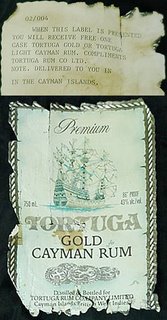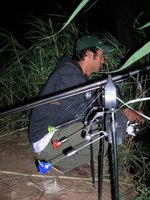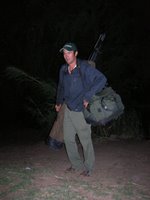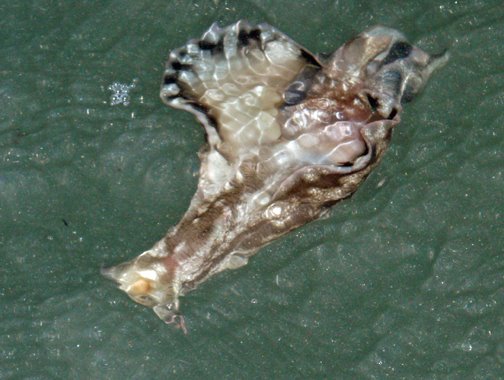
It's not every day one gets to introduce a new word into a foreign language. Like,
"dinkas," for instance. As in
"truchas dinkas."Here at home, we don't even bother to specify "trout." When you mention "dinks," everyone knows you are talking about undersized specks.
In May 2002, I drove 10 hours from Austin to La Pesca, Tamaulipas, to fish some new water.
La Pesca sits at the confluence of the Rio Soto la Marina and the Gulf of Mexico. To the south, the shallow, mangrove-lined Laguna Morales opens off the river at its mouth. To the north, another shallow estuary provides a nursery for shrimp and fishes before sinking into a series of salt pans that end in sand and thorny desert shrub before the land gives way to Laguna Madre.
It is a landscape at once intriguing and forbidding--enough like the Texas coast to seem familiar, yet touched here and there with exotic hints that you are, after all, only some 40 miles north of the Tropic of Cancer.
Hints like the hills on the horizon beyond the bay, and the flocks of parrots that forage noisily along the river banks. And citrus and papaya trees, coconuts, and mangos for the picking in carefully tended gardens.

I approach every bit of new water with a sort of nervous excitement.
Anything, I think, might be lurking under the surface. A 13-pound trout (like the one a local guide said he once caught in Laguna Morales), a monster snook … maybe even a trout rod-sized tarpon.
The nervousness, of course, comes from the fear that there may be nothing lurking under the surface of the water, or, at best, only
truchas dinkas.
That first trip, a year ago, we caught the heck out of those little trout. They were beautiful--spotted nose to tail--and feisty, attacking topwater lures twice their size.
The snook and tarpon fishing was best later in the year, I was told, November through March or thereabouts. So, in February, we saddled-up for round two, loaded a truck and a van, and headed south.
This time, we crossed the border at Nuevo Progresso, near Weslaco. This dusty little border town is a low-stress gateway (it avoids the seemingly endless, speed-bump-ridden suburbs of Matamoras) to Mexico 180 and points south.
Plus, the crowds at immigration here are typically light. With two vehicles and five fishermen, we got through the formalities in about half an hour.
The Mexican highways are generally in excellent shape between the border and La Pesca, and drive time was a manageable 4 hours, 20 minutes. We arrived after dark and settled in at Hotel La Quinta, a charming (and clean) establishment right on the river.
Humberto Hernandez, the owner, is an American-born missionary who has fished the area for more than two decades.

The day after our arrival, we opted to wade Laguna Morales, and through the hotel arranged for a guide to pick us up at the dock. Lupe arrived just after lunch, and an hour later, we were knee-deep on some of the prettiest, grass-covered flats you have ever seen.
Perfect, as my friend Danny pointed out, except for one small detail: no fish. Actually, we did pick up a few fish, spotted seatrout in the 14- to 17-inch range, but not what one would expect for five experienced coastal anglers fishing hard for four hours.
Over fajitas and cervezas back at the hotel that evening, we decided the next day we would head up the beach north of town to
Paso Corriente, the southernmost pass on the Mexican Laguna Madre.
We met Lupe at 5:30 in the morning and loaded up our buddy Charlie's Ford quad-cab four-wheel drive. Lupe brought a 25-hp outboard.
Some two hours and 35 miles of hard driving later, we arrived at the jettied pass. Along the way, we drove through some of the most remote and unpeopled beach I have ever seen, and that includes Padre Island National Seashore.
At the pass, we split-up. Half of the group ferried over to the north shore to try their luck wading, and Danny and I headed into the Laguna with Lupe. As we motored into the bay, Lupe pointed at two
lanchas in the channel and shook his head disapprovingly.

"
Nettas," he said. Seems the season on white mullet, or
lisas, as they are called locally, was closed, but that didn't stop some commercial fisherman.
"
Corvina (red drum) usually are very good here," Lupe said in Spanish. Not too long before, he said, he had guided a Mexican television crew to the area and loaded-up on big bull reds."The water was very clear," Lupe said. "It was beautiful."
Not so for us. A brisk north wind and opposing, incoming tide imbued the water coming through the pass with a latte-like color, streaked here and there with cleaner green.
As we threaded our way through the
charrangas, or fish traps, that choke the entrance to the lagoon, we decided to take our guide's advice, abandoned artificials, and began fishing with live shrimp under popping corks. When that failed, we threw fresh-cut mullet.
Still,
nada. Mid-afternoon, after trying the action on the jetties and catching a few hardhead catfish, we decided to call it a day. On the way back, we stopped to beach comb and picked up some beautifully weathered chunks of coral, and the shells of two recently deceased sea turtles tempted us.
Humberto seemed sincerely surprised--and dismayed--that we got so thoroughly skunked in one of his favorite fishing holes. He questioned us closely on where and how we fished, and finally shrugged.
"I just don't know," he said. "That's very strange that you didn't catch anything."
And so it was; the Gulf Coast around La Pesca seems to have everything a great fishery requires; easy access to the Gulf, strong freshwater inflow, tremendous amounts of cover and forage--we saw evidence of plentiful shrimp, crabs, and baitfishes.
The one thing it does not have is effective fisheries management.
In his book,
Plugger, legendary Gulf Coast wade-fisherman Rudy Grigar talks about fishing Mexico's "eighth pass" in the 1940s and 1950s. It was, he writes, snook heaven.
As late as the early 1970s, he reported incredible catches of snook, redfish, flounder, and trout. Grigar wrote that he also caught "thousands" of tarpon in the 6- to 12-pound range. In the 1940s, locals dynamited the fish for fertilizer.
There are some tarpon left. A friend from Rockport jumped and eventually landed one in the 50-pound range a year ago near
Punta Piedra (Rock Point) on the Mexican Laguna Madre.

During a visit several months after that incident, we saw the butchered carcass of a large "Silver King" resting atop a gill net.
After our disappointing foray up the beach, Humberto made a flurry of phone calls and told they were catching snook near the confluence of the Rio Palma and Rio Soto la Marina, 15 to 20 miles upstream from the hotel. We opted to pass in favor of an early start back to Texas the next day.
Later that night, as several of us teased the occasional trout from beneath the dock lights, and caught dozens of small mangrove snapper on light tackle, Humberto admitted that fishing in La Pesca is not what it used to be.
"We have laws in place to protect the resource," he said. "But the government doesn't enforce them like it should. Fishing here used to be incredible."
It can still be good--if you catch it at the right time. locals told us.
After two attempts, some in our party probably will not give La Pesca another chance--but I will.
It is still "new water" to me, and until I have tried every trick in my bag, in every season, I will not be convinced that it cannot fulfill the promise implicit in those grassy, bait-filled flats and winding, mangrove-lined channels.
Even if the fishing continues to disappoint, there are far worse ways to spend a weekend than watching pelicans and ospreys fish as the sun sets beyond the
Sierra de San Jose de las Rusias on the far side of the river.
My father, who was skeptical about the last trip even before we came up empty-handed, ended up having a wonderful time.
"Sure, it's nice to talk about all the fish you caught," he said. "But isn't it also nice to be able to have an adventure, even if you couldn't have fresh grilled fish flavored with the juice of hand-picked limes?"
"On second thought," he added, "It would have been awfully nice to have that fish to go with the adventure."
La Pesca Logistics La Pesca is not Cancun. Fishing is the main industry here, and while quite a few Mexicans from Monterey and other inland cities make the trek to the beach on weekends and holidays, very few Americans find their way so far off the beaten track.
English is not widely spoken, and U.S. dollars are truly foreign currency. The upside of all this is that prices remain reasonable, and border- and tourist-town hassles from peddlers and other locals are virtually non-existent.
Hotel rooms go for about $35-$45 per night for a clean double with air conditioning and hot water at any of the dozen or so establishments lining the river on the way in to town.
Reservations typically are not required except during Holy Week (Easter) or in August. There are several decent restaurants in town, serving primarily seafood.
Several "super-minis," or convenience stores, provide everything from bait to beer to fresh fruit and vegetables. Most of the hotels have on-site kitchens and will make meals to order, and allow guests the use of grills on the property.
There are three checkpoints manned by various agencies heading south, and two on the return trip. We were treated courteously at each on both of our trips, and in most cases were waved through with only a perfunctory inspection.
U.S. authorities perform the most thorough searches upon re-entry.
The possession of firearms and ammunition by tourists is strictly prohibited. Hunters can make prior arrangements with lodges in Mexico, but for the average tourist or angler, getting caught with an errant shotgun shell or handgun brings immediate incarceration.
La Pesca has a number of boat ramps, and experienced fishermen may want to consider taking their own boats. Navigation is fairly straightforward and, in our experience, the biggest service local guides provide is transportation.
Guides can be booked very reasonably through any of the hotels; our five-hour trip to Laguna Morales cost a total of about $58.
 In my last column, I said that paddlers these days have plenty of good choices when it comes to finding a boat they’ll enjoy. A quick look at the offerings from five leading U.S. manufacturers of plastic kayaks, and I see something on the order of 40 different models that could credibly be used for fishing.
In my last column, I said that paddlers these days have plenty of good choices when it comes to finding a boat they’ll enjoy. A quick look at the offerings from five leading U.S. manufacturers of plastic kayaks, and I see something on the order of 40 different models that could credibly be used for fishing. The rule of thumb is that longer kayaks are generally faster and track straighter. Like all displacement hull forms, a kayak’s top speed is dictated by the length of its waterline.
The rule of thumb is that longer kayaks are generally faster and track straighter. Like all displacement hull forms, a kayak’s top speed is dictated by the length of its waterline.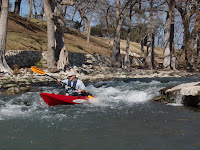
 For those who don’t want to commit to either end of the spectrum, a range of mid-sized boats – including the Ocean Kayak Prowler 13, Tarpon 140 and Hurricane Phoenix (also 14 feet long) – offer good, all-around functionality, but miss the high notes the longer and shorter boats can hit when used in their respective niches.
For those who don’t want to commit to either end of the spectrum, a range of mid-sized boats – including the Ocean Kayak Prowler 13, Tarpon 140 and Hurricane Phoenix (also 14 feet long) – offer good, all-around functionality, but miss the high notes the longer and shorter boats can hit when used in their respective niches.

